Rubric Best Practices, Examples, and Templates
A rubric is a scoring tool that identifies the different criteria relevant to an assignment, assessment, or learning outcome and states the possible levels of achievement in a specific, clear, and objective way. Use rubrics to assess project-based student work including essays, group projects, creative endeavors, and oral presentations.
Rubrics can help instructors communicate expectations to students and assess student work fairly, consistently and efficiently. Rubrics can provide students with informative feedback on their strengths and weaknesses so that they can reflect on their performance and work on areas that need improvement.

How to Get Started
Best practices, moodle how-to guides.
- Workshop Recording (Fall 2022)
- Workshop Registration
Step 1: Analyze the assignment
The first step in the rubric creation process is to analyze the assignment or assessment for which you are creating a rubric. To do this, consider the following questions:
- What is the purpose of the assignment and your feedback? What do you want students to demonstrate through the completion of this assignment (i.e. what are the learning objectives measured by it)? Is it a summative assessment, or will students use the feedback to create an improved product?
- Does the assignment break down into different or smaller tasks? Are these tasks equally important as the main assignment?
- What would an “excellent” assignment look like? An “acceptable” assignment? One that still needs major work?
- How detailed do you want the feedback you give students to be? Do you want/need to give them a grade?
Step 2: Decide what kind of rubric you will use
Types of rubrics: holistic, analytic/descriptive, single-point
Holistic Rubric. A holistic rubric includes all the criteria (such as clarity, organization, mechanics, etc.) to be considered together and included in a single evaluation. With a holistic rubric, the rater or grader assigns a single score based on an overall judgment of the student’s work, using descriptions of each performance level to assign the score.
Advantages of holistic rubrics:
- Can p lace an emphasis on what learners can demonstrate rather than what they cannot
- Save grader time by minimizing the number of evaluations to be made for each student
- Can be used consistently across raters, provided they have all been trained
Disadvantages of holistic rubrics:
- Provide less specific feedback than analytic/descriptive rubrics
- Can be difficult to choose a score when a student’s work is at varying levels across the criteria
- Any weighting of c riteria cannot be indicated in the rubric
Analytic/Descriptive Rubric . An analytic or descriptive rubric often takes the form of a table with the criteria listed in the left column and with levels of performance listed across the top row. Each cell contains a description of what the specified criterion looks like at a given level of performance. Each of the criteria is scored individually.
Advantages of analytic rubrics:
- Provide detailed feedback on areas of strength or weakness
- Each criterion can be weighted to reflect its relative importance
Disadvantages of analytic rubrics:
- More time-consuming to create and use than a holistic rubric
- May not be used consistently across raters unless the cells are well defined
- May result in giving less personalized feedback
Single-Point Rubric . A single-point rubric is breaks down the components of an assignment into different criteria, but instead of describing different levels of performance, only the “proficient” level is described. Feedback space is provided for instructors to give individualized comments to help students improve and/or show where they excelled beyond the proficiency descriptors.
Advantages of single-point rubrics:
- Easier to create than an analytic/descriptive rubric
- Perhaps more likely that students will read the descriptors
- Areas of concern and excellence are open-ended
- May removes a focus on the grade/points
- May increase student creativity in project-based assignments
Disadvantage of analytic rubrics: Requires more work for instructors writing feedback
Step 3 (Optional): Look for templates and examples.
You might Google, “Rubric for persuasive essay at the college level” and see if there are any publicly available examples to start from. Ask your colleagues if they have used a rubric for a similar assignment. Some examples are also available at the end of this article. These rubrics can be a great starting point for you, but consider steps 3, 4, and 5 below to ensure that the rubric matches your assignment description, learning objectives and expectations.
Step 4: Define the assignment criteria
Make a list of the knowledge and skills are you measuring with the assignment/assessment Refer to your stated learning objectives, the assignment instructions, past examples of student work, etc. for help.
Helpful strategies for defining grading criteria:
- Collaborate with co-instructors, teaching assistants, and other colleagues
- Brainstorm and discuss with students
- Can they be observed and measured?
- Are they important and essential?
- Are they distinct from other criteria?
- Are they phrased in precise, unambiguous language?
- Revise the criteria as needed
- Consider whether some are more important than others, and how you will weight them.
Step 5: Design the rating scale
Most ratings scales include between 3 and 5 levels. Consider the following questions when designing your rating scale:
- Given what students are able to demonstrate in this assignment/assessment, what are the possible levels of achievement?
- How many levels would you like to include (more levels means more detailed descriptions)
- Will you use numbers and/or descriptive labels for each level of performance? (for example 5, 4, 3, 2, 1 and/or Exceeds expectations, Accomplished, Proficient, Developing, Beginning, etc.)
- Don’t use too many columns, and recognize that some criteria can have more columns that others . The rubric needs to be comprehensible and organized. Pick the right amount of columns so that the criteria flow logically and naturally across levels.
Step 6: Write descriptions for each level of the rating scale
Artificial Intelligence tools like Chat GPT have proven to be useful tools for creating a rubric. You will want to engineer your prompt that you provide the AI assistant to ensure you get what you want. For example, you might provide the assignment description, the criteria you feel are important, and the number of levels of performance you want in your prompt. Use the results as a starting point, and adjust the descriptions as needed.
Building a rubric from scratch
For a single-point rubric , describe what would be considered “proficient,” i.e. B-level work, and provide that description. You might also include suggestions for students outside of the actual rubric about how they might surpass proficient-level work.
For analytic and holistic rubrics , c reate statements of expected performance at each level of the rubric.
- Consider what descriptor is appropriate for each criteria, e.g., presence vs absence, complete vs incomplete, many vs none, major vs minor, consistent vs inconsistent, always vs never. If you have an indicator described in one level, it will need to be described in each level.
- You might start with the top/exemplary level. What does it look like when a student has achieved excellence for each/every criterion? Then, look at the “bottom” level. What does it look like when a student has not achieved the learning goals in any way? Then, complete the in-between levels.
- For an analytic rubric , do this for each particular criterion of the rubric so that every cell in the table is filled. These descriptions help students understand your expectations and their performance in regard to those expectations.
Well-written descriptions:
- Describe observable and measurable behavior
- Use parallel language across the scale
- Indicate the degree to which the standards are met
Step 7: Create your rubric
Create your rubric in a table or spreadsheet in Word, Google Docs, Sheets, etc., and then transfer it by typing it into Moodle. You can also use online tools to create the rubric, but you will still have to type the criteria, indicators, levels, etc., into Moodle. Rubric creators: Rubistar , iRubric
Step 8: Pilot-test your rubric
Prior to implementing your rubric on a live course, obtain feedback from:
- Teacher assistants
Try out your new rubric on a sample of student work. After you pilot-test your rubric, analyze the results to consider its effectiveness and revise accordingly.
- Limit the rubric to a single page for reading and grading ease
- Use parallel language . Use similar language and syntax/wording from column to column. Make sure that the rubric can be easily read from left to right or vice versa.
- Use student-friendly language . Make sure the language is learning-level appropriate. If you use academic language or concepts, you will need to teach those concepts.
- Share and discuss the rubric with your students . Students should understand that the rubric is there to help them learn, reflect, and self-assess. If students use a rubric, they will understand the expectations and their relevance to learning.
- Consider scalability and reusability of rubrics. Create rubric templates that you can alter as needed for multiple assignments.
- Maximize the descriptiveness of your language. Avoid words like “good” and “excellent.” For example, instead of saying, “uses excellent sources,” you might describe what makes a resource excellent so that students will know. You might also consider reducing the reliance on quantity, such as a number of allowable misspelled words. Focus instead, for example, on how distracting any spelling errors are.
Example of an analytic rubric for a final paper
Example of a holistic rubric for a final paper, single-point rubric, more examples:.
- Single Point Rubric Template ( variation )
- Analytic Rubric Template make a copy to edit
- A Rubric for Rubrics
- Bank of Online Discussion Rubrics in different formats
- Mathematical Presentations Descriptive Rubric
- Math Proof Assessment Rubric
- Kansas State Sample Rubrics
- Design Single Point Rubric
Technology Tools: Rubrics in Moodle
- Moodle Docs: Rubrics
- Moodle Docs: Grading Guide (use for single-point rubrics)
Tools with rubrics (other than Moodle)
- Google Assignments
- Turnitin Assignments: Rubric or Grading Form
Other resources
- DePaul University (n.d.). Rubrics .
- Gonzalez, J. (2014). Know your terms: Holistic, Analytic, and Single-Point Rubrics . Cult of Pedagogy.
- Goodrich, H. (1996). Understanding rubrics . Teaching for Authentic Student Performance, 54 (4), 14-17. Retrieved from
- Miller, A. (2012). Tame the beast: tips for designing and using rubrics.
- Ragupathi, K., Lee, A. (2020). Beyond Fairness and Consistency in Grading: The Role of Rubrics in Higher Education. In: Sanger, C., Gleason, N. (eds) Diversity and Inclusion in Global Higher Education. Palgrave Macmillan, Singapore.
Eberly Center
Teaching excellence & educational innovation, grading and performance rubrics, what are rubrics.
A rubric is a scoring tool that explicitly represents the performance expectations for an assignment or piece of work. A rubric divides the assigned work into component parts and provides clear descriptions of the characteristics of the work associated with each component, at varying levels of mastery. Rubrics can be used for a wide array of assignments: papers, projects, oral presentations, artistic performances, group projects, etc. Rubrics can be used as scoring or grading guides, to provide formative feedback to support and guide ongoing learning efforts, or both.
Advantages of Using Rubrics
Using a rubric provides several advantages to both instructors and students. Grading according to an explicit and descriptive set of criteria that is designed to reflect the weighted importance of the objectives of the assignment helps ensure that the instructor’s grading standards don’t change over time. Grading consistency is difficult to maintain over time because of fatigue, shifting standards based on prior experience, or intrusion of other criteria. Furthermore, rubrics can reduce the time spent grading by reducing uncertainty and by allowing instructors to refer to the rubric description associated with a score rather than having to write long comments. Finally, grading rubrics are invaluable in large courses that have multiple graders (other instructors, teaching assistants, etc.) because they can help ensure consistency across graders and reduce the systematic bias that can be introduced between graders.
Used more formatively, rubrics can help instructors get a clearer picture of the strengths and weaknesses of their class. By recording the component scores and tallying up the number of students scoring below an acceptable level on each component, instructors can identify those skills or concepts that need more instructional time and student effort.
Grading rubrics are also valuable to students. A rubric can help instructors communicate to students the specific requirements and acceptable performance standards of an assignment. When rubrics are given to students with the assignment description, they can help students monitor and assess their progress as they work toward clearly indicated goals. When assignments are scored and returned with the rubric, students can more easily recognize the strengths and weaknesses of their work and direct their efforts accordingly.
Examples of Rubrics
Here are links to a diverse set of rubrics designed by Carnegie Mellon faculty and faculty at other institutions. Although your particular field of study and type of assessment activity may not be represented currently, viewing a rubric that is designed for a similar activity may provide you with ideas on how to divide your task into components and how to describe the varying levels of mastery.
Paper Assignments
- Example 1: Philosophy Paper This rubric was designed for student papers in a range of philosophy courses, CMU.
- Example 2: Psychology Assignment Short, concept application homework assignment in cognitive psychology, CMU.
- Example 3: Anthropology Writing Assignments This rubric was designed for a series of short writing assignments in anthropology, CMU.
- Example 4: History Research Paper . This rubric was designed for essays and research papers in history, CMU.
- Example 1: Capstone Project in Design This rubric describes the components and standard of performance from the research phase to the final presentation for a senior capstone project in the School of Design, CMU.
- Example 2: Engineering Design Project This rubric describes performance standards on three aspects of a team project: Research and Design, Communication, and Team Work.
Oral Presentations
- Example 1: Oral Exam This rubric describes a set of components and standards for assessing performance on an oral exam in an upper-division history course, CMU.
- Example 2: Oral Communication
- Example 3: Group Presentations This rubric describes a set of components and standards for assessing group presentations in a history course, CMU.
Class Participation/Contributions
- Example 1: Discussion Class This rubric assesses the quality of student contributions to class discussions. This is appropriate for an undergraduate-level course, CMU.
- Example 2: Advanced Seminar This rubric is designed for assessing discussion performance in an advanced undergraduate or graduate seminar.
Rubrics for Oral Presentations
Introduction.
Many instructors require students to give oral presentations, which they evaluate and count in students’ grades. It is important that instructors clarify their goals for these presentations as well as the student learning objectives to which they are related. Embedding the assignment in course goals and learning objectives allows instructors to be clear with students about their expectations and to develop a rubric for evaluating the presentations.
A rubric is a scoring guide that articulates and assesses specific components and expectations for an assignment. Rubrics identify the various criteria relevant to an assignment and then explicitly state the possible levels of achievement along a continuum, so that an effective rubric accurately reflects the expectations of an assignment. Using a rubric to evaluate student performance has advantages for both instructors and students. Creating Rubrics
Rubrics can be either analytic or holistic. An analytic rubric comprises a set of specific criteria, with each one evaluated separately and receiving a separate score. The template resembles a grid with the criteria listed in the left column and levels of performance listed across the top row, using numbers and/or descriptors. The cells within the center of the rubric contain descriptions of what expected performance looks like for each level of performance.
A holistic rubric consists of a set of descriptors that generate a single, global score for the entire work. The single score is based on raters’ overall perception of the quality of the performance. Often, sentence- or paragraph-length descriptions of different levels of competencies are provided.
When applied to an oral presentation, rubrics should reflect the elements of the presentation that will be evaluated as well as their relative importance. Thus, the instructor must decide whether to include dimensions relevant to both form and content and, if so, which one. Additionally, the instructor must decide how to weight each of the dimensions – are they all equally important, or are some more important than others? Additionally, if the presentation represents a group project, the instructor must decide how to balance grading individual and group contributions. Evaluating Group Projects
Creating Rubrics
The steps for creating an analytic rubric include the following:
1. Clarify the purpose of the assignment. What learning objectives are associated with the assignment?
2. Look for existing rubrics that can be adopted or adapted for the specific assignment
3. Define the criteria to be evaluated
4. Choose the rating scale to measure levels of performance
5. Write descriptions for each criterion for each performance level of the rating scale
6. Test and revise the rubric
Examples of criteria that have been included in rubrics for evaluation oral presentations include:
- Knowledge of content
- Organization of content
- Presentation of ideas
- Research/sources
- Visual aids/handouts
- Language clarity
- Grammatical correctness
- Time management
- Volume of speech
- Rate/pacing of Speech
- Mannerisms/gestures
- Eye contact/audience engagement
Examples of scales/ratings that have been used to rate student performance include:
- Strong, Satisfactory, Weak
- Beginning, Intermediate, High
- Exemplary, Competent, Developing
- Excellent, Competent, Needs Work
- Exceeds Standard, Meets Standard, Approaching Standard, Below Standard
- Exemplary, Proficient, Developing, Novice
- Excellent, Good, Marginal, Unacceptable
- Advanced, Intermediate High, Intermediate, Developing
- Exceptional, Above Average, Sufficient, Minimal, Poor
- Master, Distinguished, Proficient, Intermediate, Novice
- Excellent, Good, Satisfactory, Poor, Unacceptable
- Always, Often, Sometimes, Rarely, Never
- Exemplary, Accomplished, Acceptable, Minimally Acceptable, Emerging, Unacceptable
Grading and Performance Rubrics Carnegie Mellon University Eberly Center for Teaching Excellence & Educational Innovation
Creating and Using Rubrics Carnegie Mellon University Eberly Center for Teaching Excellence & Educational Innovation
Using Rubrics Cornell University Center for Teaching Innovation
Rubrics DePaul University Teaching Commons
Building a Rubric University of Texas/Austin Faculty Innovation Center
Building a Rubric Columbia University Center for Teaching and Learning
Rubric Development University of West Florida Center for University Teaching, Learning, and Assessment
Creating and Using Rubrics Yale University Poorvu Center for Teaching and Learning
Designing Grading Rubrics Brown University Sheridan Center for Teaching and Learning
Examples of Oral Presentation Rubrics
Oral Presentation Rubric Pomona College Teaching and Learning Center
Oral Presentation Evaluation Rubric University of Michigan
Oral Presentation Rubric Roanoke College
Oral Presentation: Scoring Guide Fresno State University Office of Institutional Effectiveness
Presentation Skills Rubric State University of New York/New Paltz School of Business
Oral Presentation Rubric Oregon State University Center for Teaching and Learning
Oral Presentation Rubric Purdue University College of Science
Group Class Presentation Sample Rubric Pepperdine University Graziadio Business School
Center for Teaching Innovation
Resource library.
- AACU VALUE Rubrics
Using rubrics
A rubric is a type of scoring guide that assesses and articulates specific components and expectations for an assignment. Rubrics can be used for a variety of assignments: research papers, group projects, portfolios, and presentations.
Why use rubrics?
Rubrics help instructors:
- Assess assignments consistently from student-to-student.
- Save time in grading, both short-term and long-term.
- Give timely, effective feedback and promote student learning in a sustainable way.
- Clarify expectations and components of an assignment for both students and course teaching assistants (TAs).
- Refine teaching methods by evaluating rubric results.
Rubrics help students:
- Understand expectations and components of an assignment.
- Become more aware of their learning process and progress.
- Improve work through timely and detailed feedback.
Considerations for using rubrics
When developing rubrics consider the following:
- Although it takes time to build a rubric, time will be saved in the long run as grading and providing feedback on student work will become more streamlined.
- A rubric can be a fillable pdf that can easily be emailed to students.
- They can be used for oral presentations.
- They are a great tool to evaluate teamwork and individual contribution to group tasks.
- Rubrics facilitate peer-review by setting evaluation standards. Have students use the rubric to provide peer assessment on various drafts.
- Students can use them for self-assessment to improve personal performance and learning. Encourage students to use the rubrics to assess their own work.
- Motivate students to improve their work by using rubric feedback to resubmit their work incorporating the feedback.
Getting Started with Rubrics
- Start small by creating one rubric for one assignment in a semester.
- Ask colleagues if they have developed rubrics for similar assignments or adapt rubrics that are available online. For example, the AACU has rubrics for topics such as written and oral communication, critical thinking, and creative thinking. RubiStar helps you to develop your rubric based on templates.
- Examine an assignment for your course. Outline the elements or critical attributes to be evaluated (these attributes must be objectively measurable).
- Create an evaluative range for performance quality under each element; for instance, “excellent,” “good,” “unsatisfactory.”
- Avoid using subjective or vague criteria such as “interesting” or “creative.” Instead, outline objective indicators that would fall under these categories.
- The criteria must clearly differentiate one performance level from another.
- Assign a numerical scale to each level.
- Give a draft of the rubric to your colleagues and/or TAs for feedback.
- Train students to use your rubric and solicit feedback. This will help you judge whether the rubric is clear to them and will identify any weaknesses.
- Rework the rubric based on the feedback.
15 Free Rubric Templates
By Kate Eby | August 30, 2018
- Share on Facebook
- Share on Twitter
- Share on LinkedIn
Link copied
Often found in the education sector, a rubric is a tool for scoring performance based on specific criteria. However, businesses also use a rubric to measure things like employee performance and to evaluate the success of a project or product. Below you’ll find a range of free, customizable rubric templates for business and academic use. Save time and create an efficient grading process with easy-to-use, printable rubric templates.
Project Management Rubric
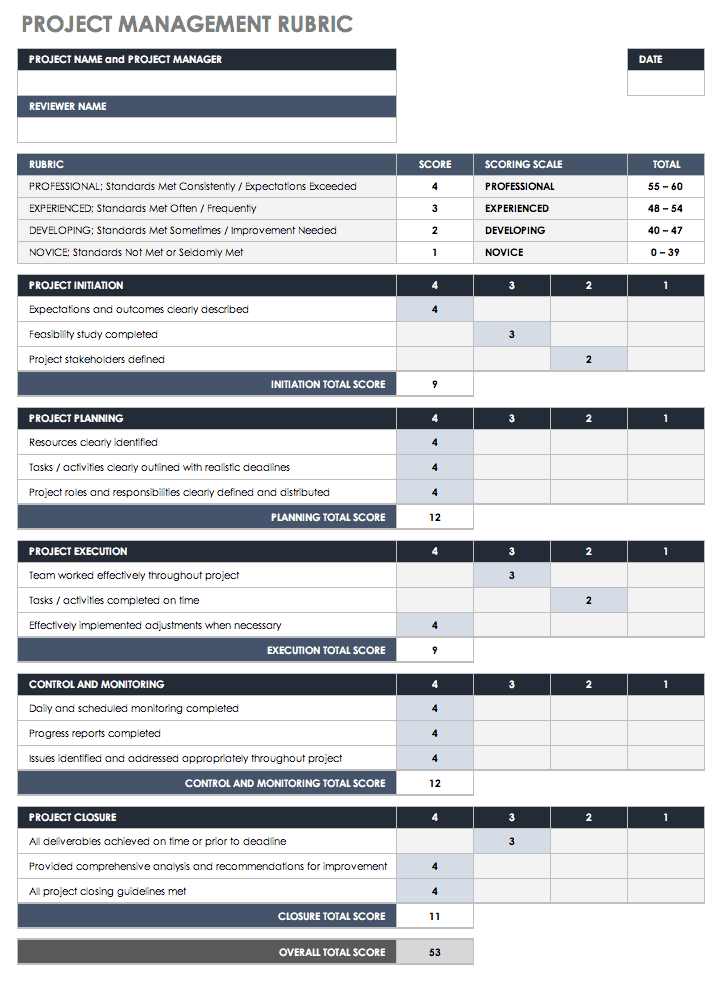
Evaluate project managers’ performance with this Excel rubric template. Enter the stages of a project or important objectives and milestones. Then use the rating scale to judge and provide a basic description of the management of those stages. This template can also be a useful self-evaluation tool for project managers to learn from and inform decision making on future projects.
Download Project Management Rubric
Excel | Word | PDF | Smartsheet
Business Plan Rubric

Break down your business plan into sections and use this rubric to evaluate the strength of each part. Is your mission statement merely sufficient, highly advanced, or somewhere inbetween? Is your market analysis thorough, or does it need to be fleshed out? Use this template to identify weak points and areas for improvement in your business plan.
Download Business Plan Rubric
Job Interview Rubric Template
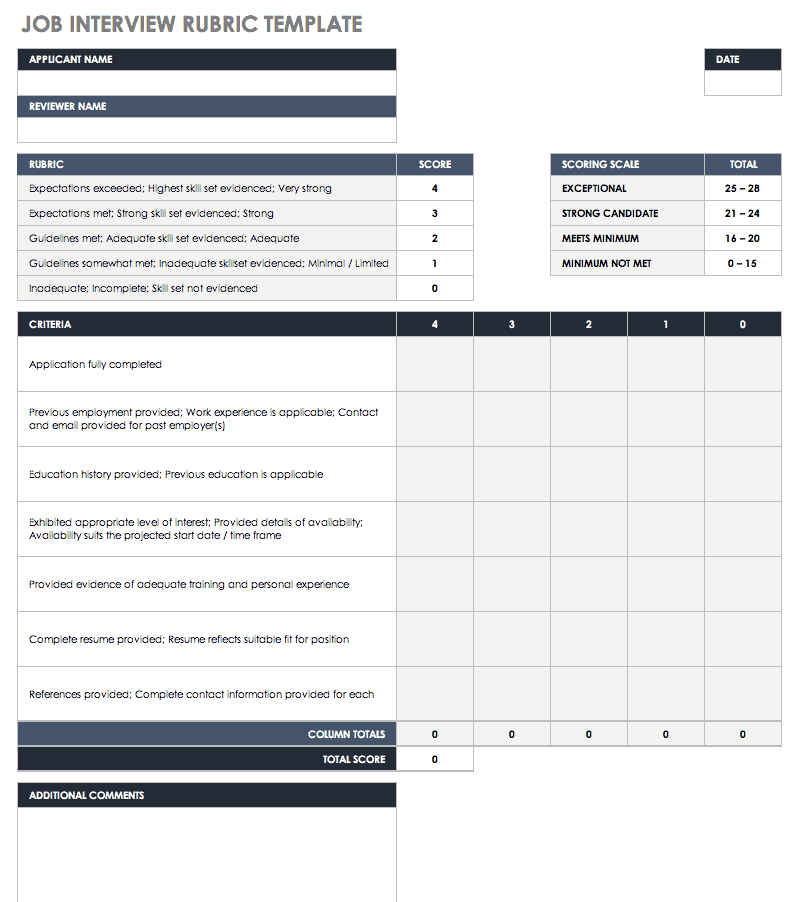
Use this rubric template to evaluate job interview candidates. Add your own criteria based on the applicant’s resume, references, skills, experience, and other important factors. The template includes a scoring scale with four levels as well as an additional column for criteria that the job candidate is missing or that are not applicable.
Download Job Interview Rubric Template
Excel | Word | PDF
Employee Performance Rubric
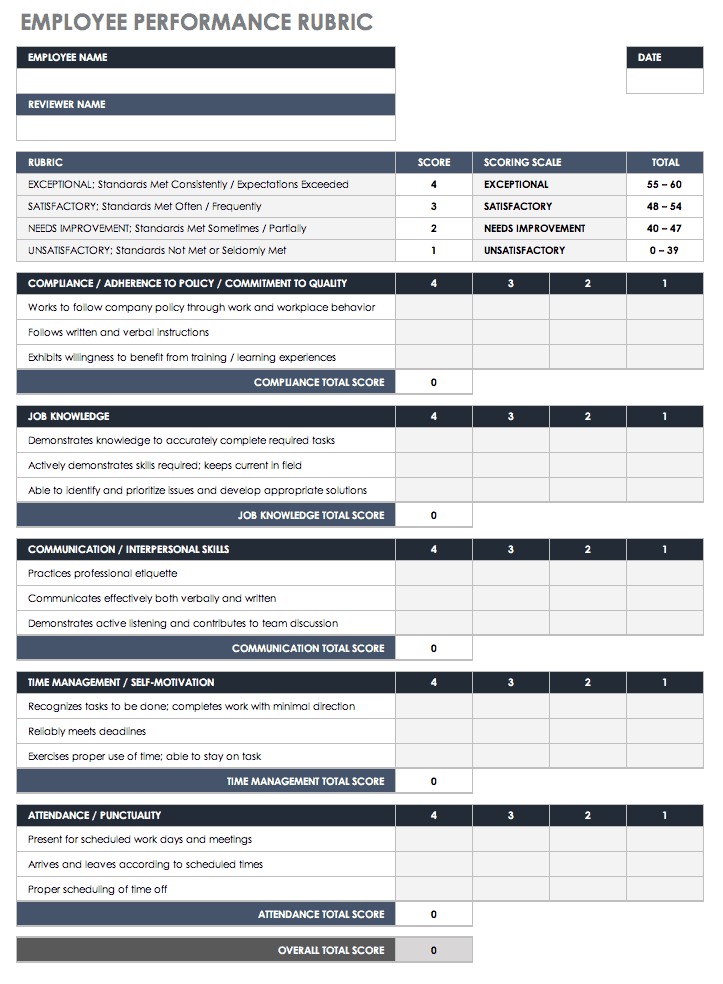
Create a rubric for ranking employee performance in selected areas, such as customer service, teamwork, leadership, time management, attendance, and other criteria. This template provides a simple way to create a comprehensive evaluation tool that you can use for multiple employees. This system of measurement helps support a fair evaluation process and provides an overview of an employee’s performance in an organized format.
Download Employee Performance Rubric
Excel | Word | PDF | Smartsheet
Product Rubric Template
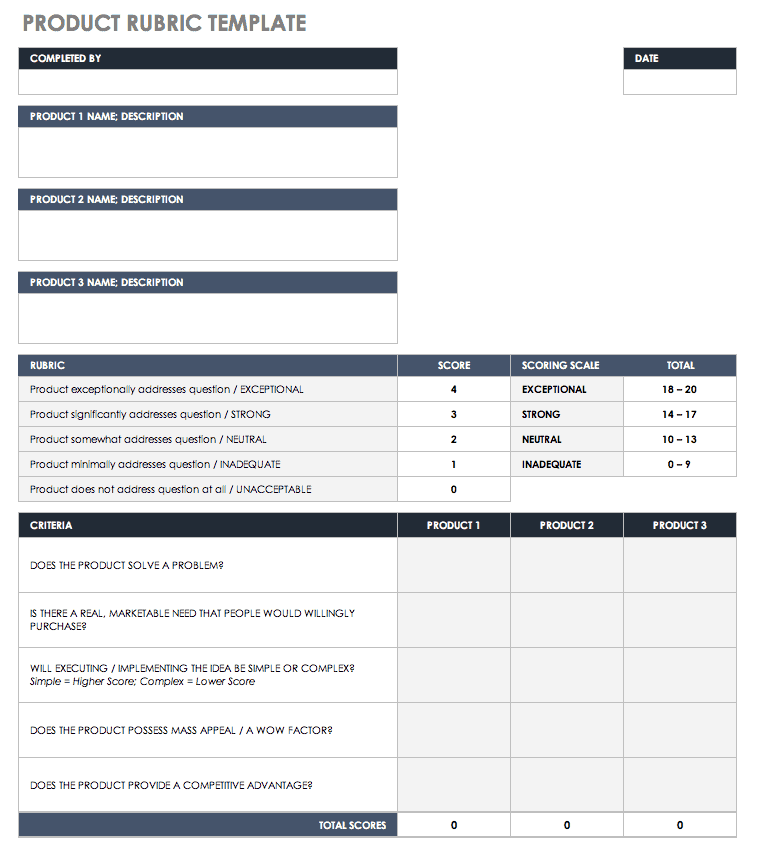
Before investing in a new product, use this rubric template to determine how it aligns with your business objectives. You can rank and compare several products to get an idea of which one may offer the best return on investment. This rubric template is available as a Word or fillable PDF file, making it easy to print and use in a team meeting or brainstorming session .
Download Product Rubric Template
Marketing Plan Rubric
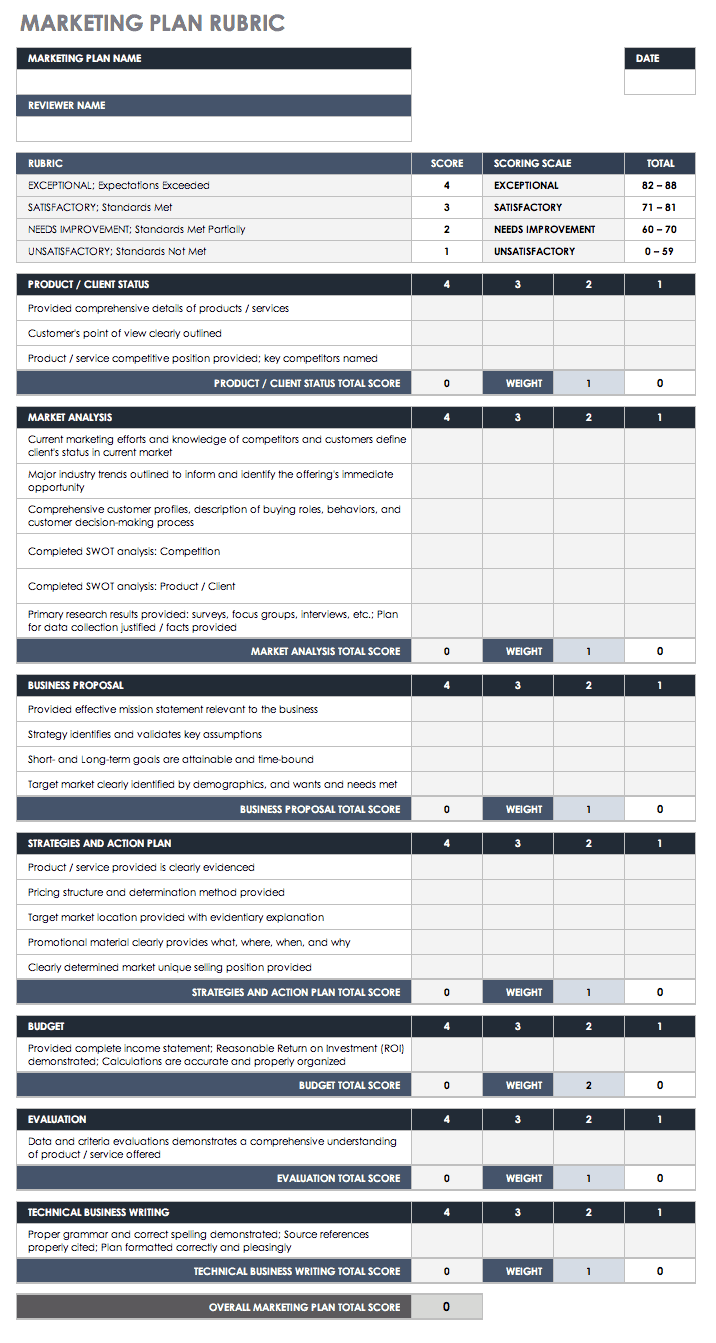
Evaluate all the elements of your marketing plan, from research and analysis to strategy and action items. Make sure your marketing plan can stand up to scrutiny and deliver results. Use this rubric template to add up points for each category and calculate a total score. The scoring system will indicate the overall strength of the marketing plan as well as which sections you need to refine or develop further.
Download Marketing Plan Rubric
Excel | Word | PDF
Group Project Rubric Template
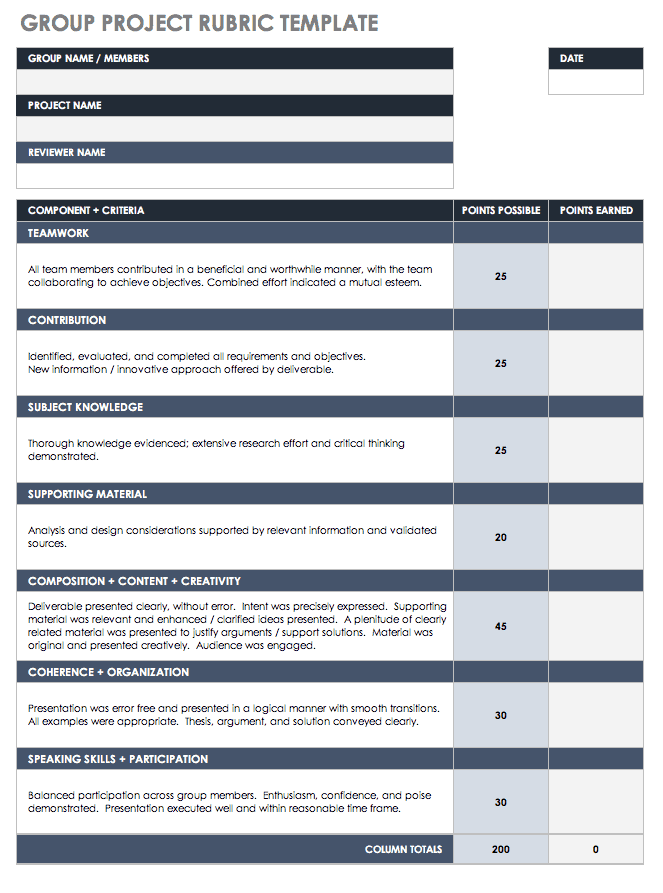
This teamwork rubric allows teachers to assess how a group handled a shared project. Evaluate both process and content by including criteria such as supporting materials used, evidence of subject knowledge, organization, and collaboration. The template offers a simple layout, but you can add grading components and detailed criteria for meeting project objectives.
Download Group Project Rubric Template
Art Grading Rubric Template
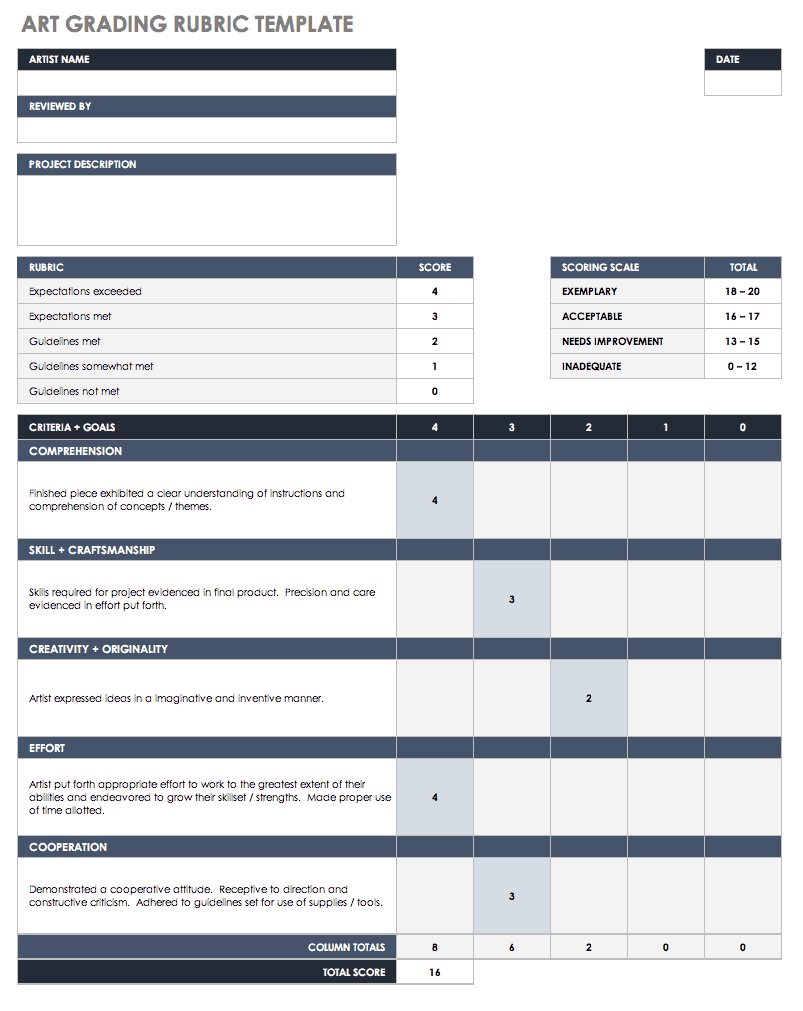
Create a rubric for grading art projects that illustrates whether students were able to meet or exceed the expectations of an assignment. You can edit this template and use it with any grade level, student ability, or type of art project. Choose your grading criteria based on what you want to evaluate, such as technique, use and care of classroom tools, or creative vision.
Download Art Grading Rubric Template
Science Experiment Rubric
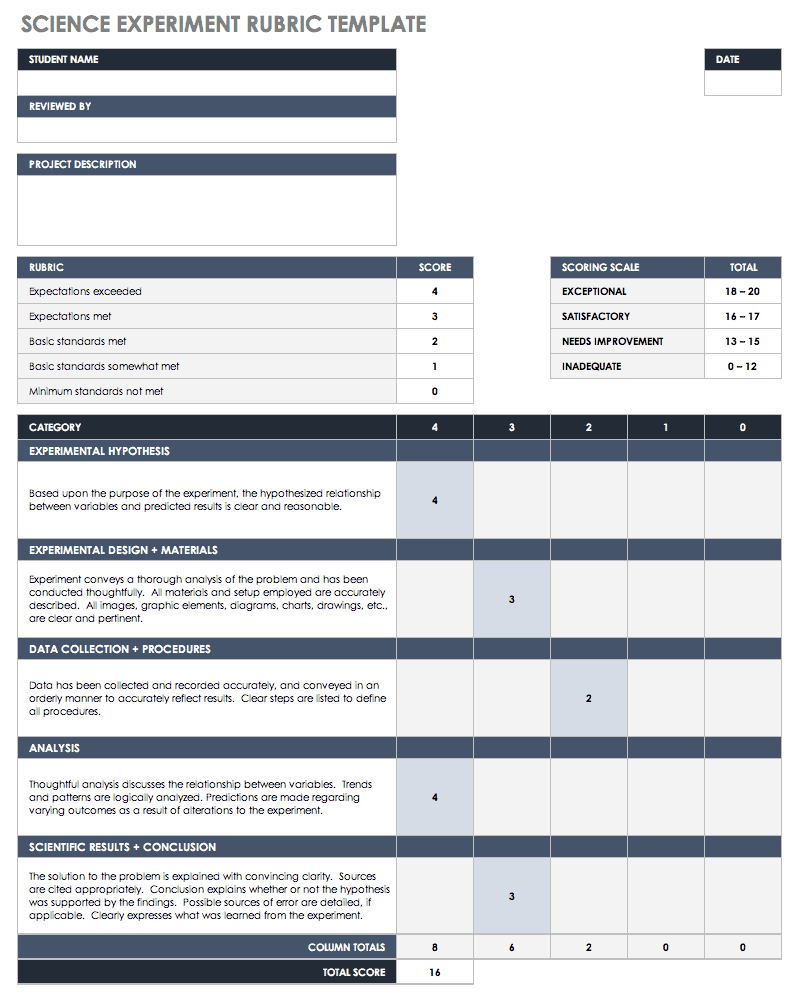
Evaluate science experiments or lab reports with this scoring rubric template. Criteria may be based on the scientific process, how procedures were followed, how data and analysis were handled, and presentation skills (if relevant). Easily modify this rubric template to include additional rows or columns for a detailed look at a student’s performance.
Download Science Experiment Rubric
Poster Rubric Template
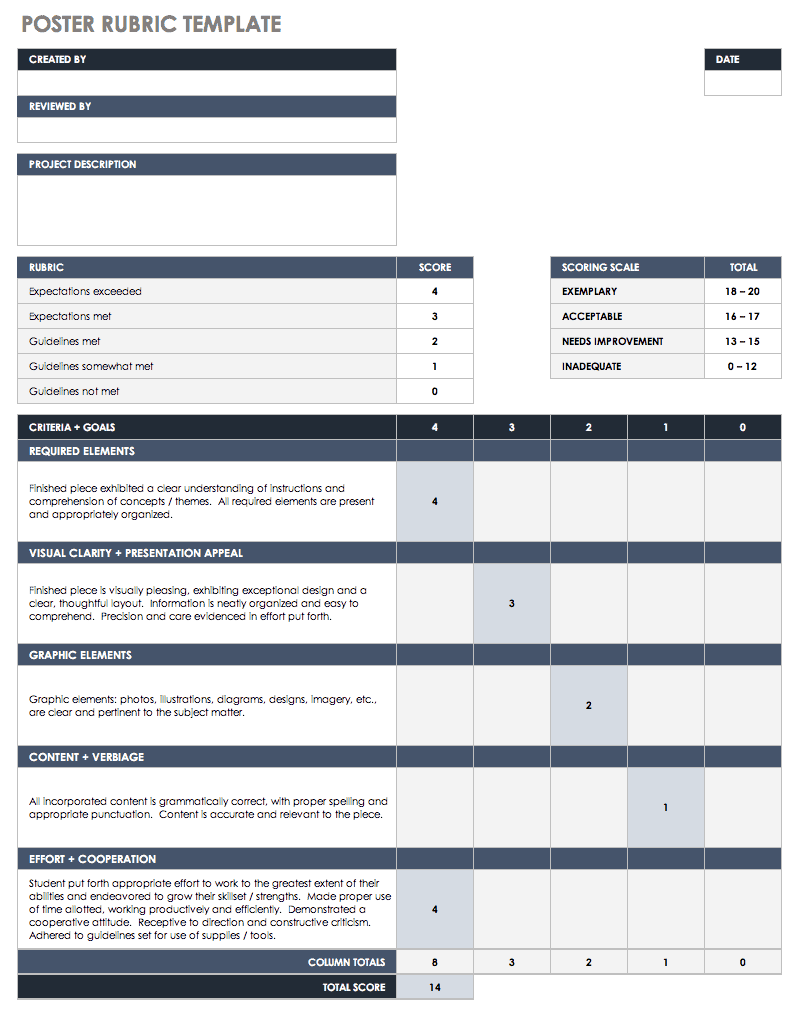
This Google Docs rubric template is designed for scoring an elementary school poster assignment. Include whatever elements you want to evaluate — such as graphics used, grammar, time management, or creativity — and add up the total score for each student’s work. Teachers can share the rubric with students to inform them of what to aim for with their poster projects.
Download Poster Rubric Template
Excel | Word | PDF | Google Docs
Research Project Rubric

Use this template to create a research project, written report, or other writing assignment rubric. Assess a student’s analytical and organizational skills, use of references, style and tone, and overall success of completing the assignment. The template includes room for additional comments about the student’s work.
Download Research Project Rubric — Excel
Oral Presentation Rubric Template

List all of the expectations for an effective oral presentation along with a point scale to create a detailed rubric. Areas to assess may include the thoroughness of the project, speaking and presentation skills, use of visual aids, and accuracy. Use this information to support the grading process and to show students areas they need to strengthen.
Download Oral Presentation Rubric Template
Grading Rubric Template
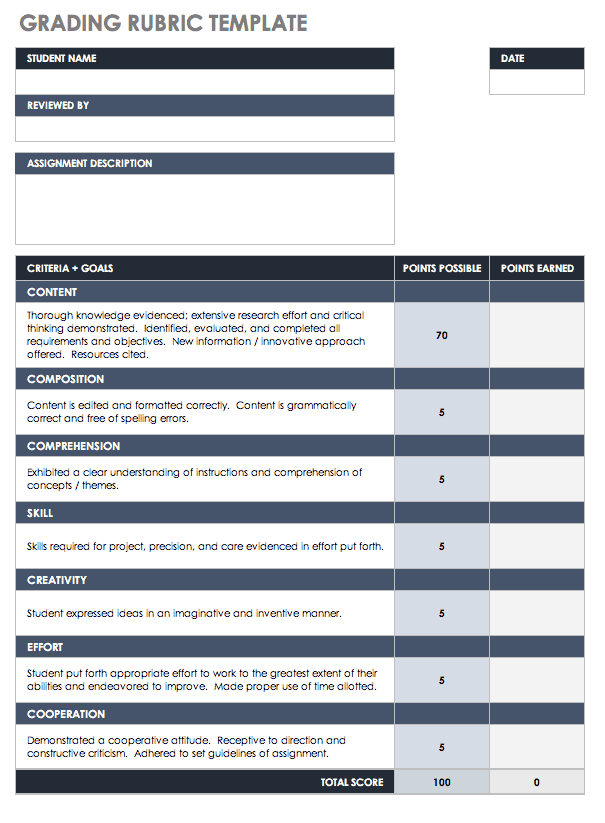
This grading rubric template provides a general outline that you can use to evaluate any type of assignment, project, or work performance. You can also use the template for self-assessment or career planning to help identify skills or training to develop. Quickly save this Google Docs template to your Google Drive account and share it with others.
Download Grading Rubric Template
Blank Rubric Template
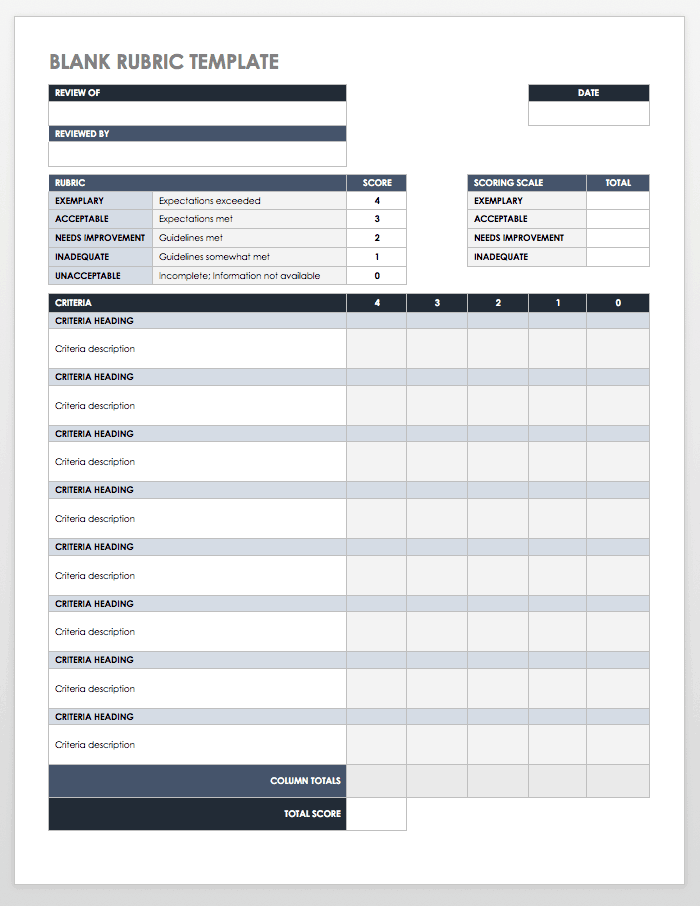
Add your own information to this blank, editable template to create an evaluation tool that suits your particular needs. You can download the rubric as a Word or PDF file and start using it immediately. Use color or formatting changes to customize the template for use in a classroom, workplace, or other setting.
Download Blank Rubric Template
Holistic Rubric Template
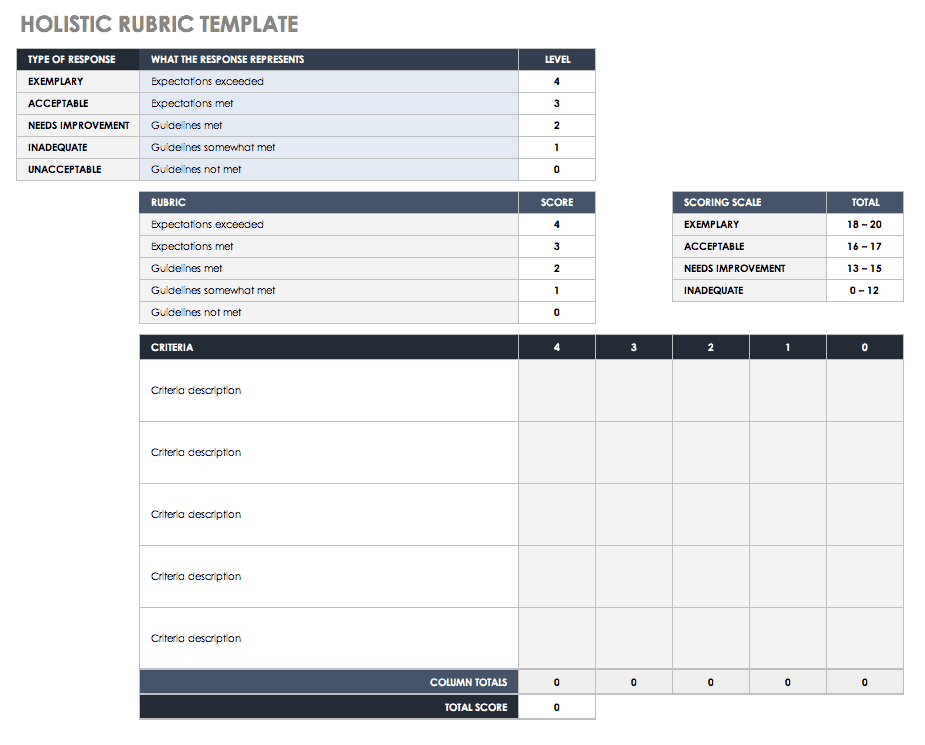
A holistic rubric provides a more generalized evaluation system by grouping together assignment requirements or performance expectations into a few levels for scoring. This method is different from analytic rubrics, which break down performance criteria into more detailed levels (which allows for more fine-tuned scoring and specific feedback for the student or employee). This holistic rubric template offers a basic outline for defining the characteristics that constitute each scoring level.
Download Holistic Rubric Template
What Is a Rubric Template?
A rubric is a tool for evaluating and scoring performance based on a set of criteria, and it provides an organized and consistent method for evaluation. Teachers commonly use rubrics to evaluate student performance at all levels of education, from elementary and high school to college. They can also be used in business settings to evaluate a project, employee, product, or strategic plan.
How to Make a Rubric Template
A variety of options exist for creating rubrics, including software, online tools, and downloadable templates. Templates provide a simple, reusable, and cost-effective solution for making a basic rubric. After downloading a rubric outline template, you can add your own criteria, text, and increase the number of rows or columns as needed.
All rubrics typically contain some version of the following elements:
- A description of the task to be evaluated
- A rating scale with at least three levels
- The criteria used to judge the task
- Descriptive language to illustrate how well the task (or performance, item, etc.) meets expectations
The rating scale on a rubric is often a combination of numbers and words (language often ranging from low to high, or poor to excellent quality). Using descriptive language allows for a thorough understanding of different elements of a task or performance, while a numeric scale allows you to quantitatively define an overall score. For example, level one may be worth one point and could be described as “beginner,” “low quality,” or “needs improvement;” level two could be worth two points and described as “fair” or “satisfactory.” The scale would continue up from there, ending with the highest level of exemplary performance.
Each of the criteria can be expanded upon with descriptive phrases to illustrate performance expectations. For example, if you were to evaluate an employee, and one of the criteria is communication skills, you would elaborate on each potential level of performance, such as in the following sample phrases:
- Level 1: Rarely shares ideas or exhibits teamwork during meetings or group projects.
- Level 2: Occasionally shares ideas or exhibits teamwork during meetings.
- Level 3: Often shares ideas or exhibits teamwork during meetings or group projects.
- Level 4: Frequently shares ideas or exhibits teamwork in meetings or group projects.
The above copy is just one example phrase with four different qualifiers, but several sentences may be required to demonstrate different aspects of communication skills and how well they are performed in various situations.
Easily Use Rubric Templates to Meet Business Goals with Real-Time Work Management in Smartsheet
Empower your people to go above and beyond with a flexible platform designed to match the needs of your team — and adapt as those needs change.
The Smartsheet platform makes it easy to plan, capture, manage, and report on work from anywhere, helping your team be more effective and get more done. Report on key metrics and get real-time visibility into work as it happens with roll-up reports, dashboards, and automated workflows built to keep your team connected and informed.
When teams have clarity into the work getting done, there’s no telling how much more they can accomplish in the same amount of time. Try Smartsheet for free, today.
Discover why over 90% of Fortune 100 companies trust Smartsheet to get work done.
Download Project Based Learning Rubrics
We've created a wide range of rubrics - for designing and teaching PBL to guiding students through key stages of the PBL process.
All of our resources – rubrics, project ideas, student handouts, videos, and more – are available at My.PBLWorks.org . You can download over 25 different rubrics there!
Go to MyPBLWorks.org for all rubrics
Below are some of the most popular rubric downloads.
Project Based Teaching Rubric
This rubric describes beginning, developing, and Gold Standard levels for Project Based Teaching Practices for K-12 teachers and features detailed, concrete indicators that illustrate what it means to teach in a PBL environment.
Teachers and school leaders can use this rubric to reflect on their practice and plan for professional growth.
Download here
Rubric for Rubrics
This rubric describes a well-written rubric, distinguishing between rubrics that meet, approach, or are below standards for selection of criteria, distinction between levels, and quality of writing. It also describes how a rubric is created and used with students.
Project Design Rubric
The Project Design Rubric uses the Essential Project Design Elements as criteria to evaluate projects. The rubric aligns with BIE's Gold Standard PBL model. Definitions and practical examples are used to clarify the meaning of each dimension.
You and your colleagues can use the rubric to guide the design of projects, give formative feedback, and reflect and revise.
Grades 9-12 Presentation Rubric
This rubric helps teachers guide students in grades 9-12 in making effective presentations in a project, and it can be used to assess their performance.
Use this rubric to guide students and assess their work, or to inform your thinking as you create your own assessment tools. Schools and districts can adopt or adapt this rubric for use across all classrooms.
Grades 6-12 Creativity & Innovation Rubric
The first part of this rubric helps teachers guide students in grades 6-12 in using an effective process for innovation in various phases of a project, and it can be used to assess their performance.
The second part of the rubric can be used to assess the degree of creativity shown in the products students create in a project.
Yes, we provide PBL training for educators! PBLWorks offers a variety of PBL workshops, courses and services for teachers, school and district leaders, and instructional coaches - whether you're just getting started or advancing your practice. Learn more
Don't miss a thing! Get PBL resources, tips and news delivered to your inbox.
- Presentation Design

Presentation Rubric for a College Project
We seem to have an unavoidable relationship with public speaking throughout our lives. From our kindergarten years, when our presentations are nothing more than a few seconds of reciting cute words in front of our class…

...till our grown up years, when things get a little more serious, and the success of our presentations may determine getting funds for our business, or obtaining an academic degree when defending our thesis.

By the time we reach our mid 20’s, we become worryingly used to evaluations based on our presentations. Yet, for some reason, we’re rarely told the traits upon which we are being evaluated. Most colleges and business schools for instance use a PowerPoint presentation rubric to evaluate their students. Funny thing is, they’re not usually that open about sharing it with their students (as if that would do any harm!).
What is a presentation rubric?
A presentation rubric is a systematic and standardized tool used to evaluate and assess the quality and effectiveness of a presentation. It provides a structured framework for instructors, evaluators, or peers to assess various aspects of a presentation, such as content, delivery, organization, and overall performance. Presentation rubrics are commonly used in educational settings, business environments, and other contexts where presentations are a key form of communication.
A typical presentation rubric includes a set of criteria and a scale for rating or scoring each criterion. The criteria are specific aspects or elements of the presentation that are considered essential for a successful presentation. The scale assigns a numerical value or descriptive level to each criterion, ranging from poor or unsatisfactory to excellent or outstanding.
Common criteria found in presentation rubrics may include:
- Content: This criterion assesses the quality and relevance of the information presented. It looks at factors like accuracy, depth of knowledge, use of evidence, and the clarity of key messages.
- Organization: Organization evaluates the structure and flow of the presentation. It considers how well the introduction, body, and conclusion are structured and whether transitions between sections are smooth.
- Delivery: Delivery assesses the presenter's speaking skills, including vocal tone, pace, clarity, and engagement with the audience. It also looks at nonverbal communication, such as body language and eye contact.
- Visual Aids: If visual aids like slides or props are used, this criterion evaluates their effectiveness, relevance, and clarity. It may also assess the design and layout of visual materials.
- Audience Engagement: This criterion measures the presenter's ability to connect with the audience, maintain their interest, and respond to questions or feedback.
- Time Management: Time management assesses whether the presenter stayed within the allotted time for the presentation. Going significantly over or under the time limit can affect the overall effectiveness of the presentation.
- Creativity and Innovation: In some cases, rubrics may include criteria related to the creative and innovative aspects of the presentation, encouraging presenters to think outside the box.
- Overall Impact: This criterion provides an overall assessment of the presentation's impact on the audience, considering how well it achieved its intended purpose and whether it left a lasting impression.
“We’re used to giving presentations, yet we’re rarely told the traits upon which we’re being evaluated.
Well, we don’t believe in shutting down information. Quite the contrary: we think the best way to practice your speech is to know exactly what is being tested! By evaluating each trait separately, you can:
- Acknowledge the complexity of public speaking, that goes far beyond subject knowledge.
- Address your weaker spots, and work on them to improve your presentation as a whole.
I’ve assembled a simple Presentation Rubric, based on a great document by the NC State University, and I've also added a few rows of my own, so you can evaluate your presentation in pretty much any scenario!
CREATE PRESENTATION
What is tested in this powerpoint presentation rubric.
The Rubric contemplates 7 traits, which are as follows:

Now let's break down each trait so you can understand what they mean, and how to assess each one:
Presentation Rubric

How to use this Rubric?:
The Rubric is pretty self explanatory, so I'm just gonna give you some ideas as to how to use it. The ideal scenario is to ask someone else to listen to your presentation and evaluate you with it. The less that person knows you, or what your presentation is about, the better.
WONDERING WHAT YOUR SCORE MAY INDICATE?
- 21-28 Fan-bloody-tastic!
- 14-21 Looking good, but you can do better
- 7-14 Uhmmm, you ain't at all ready
As we don't always have someone to rehearse our presentations with, a great way to use the Rubric is to record yourself (this is not Hollywood material so an iPhone video will do!), watching the video afterwards, and evaluating your presentation on your own. You'll be surprised by how different your perception of yourself is, in comparison to how you see yourself on video.

Related read: Webinar - Public Speaking and Stage Presence: How to wow?
It will be fairly easy to evaluate each trait! The mere exercise of reading the Presentation Rubric is an excellent study on presenting best practices.
If you're struggling with any particular trait, I suggest you take a look at our Academy Channel where we discuss how to improve each trait in detail!
It's not always easy to objectively assess our own speaking skills. So the next time you have a big presentation coming up, use this Rubric to put yourself to the test!
Need support for your presentation? Build awesome slides using our very own Slidebean .
Popular Articles

The Real Numbers Behind Shark Tank

Pitch deck structure: What Investors want to see

Let’s move your company to the next stage 🚀
Ai pitch deck software, pitch deck services.

Financial Model Consulting for Startups 🚀

Raise money with our pitch deck writing and design service 🚀

The all-in-one pitch deck software 🚀

Check out our list of the top free presentation websites that offer unique features and design options. Discover the best platform for your next presentation now.

This presentation software list is the result of weeks of research of 50+ presentation tools currently available online. It'll help you compare and decide.

This is a functional model you can use to create your own formulas and project your potential business growth. Instructions on how to use it are on the front page.

Book a call with our sales team
In a hurry? Give us a call at

Center for Excellence in Teaching
Home > Resources > Group presentation rubric
Group presentation rubric
This is a grading rubric an instructor uses to assess students’ work on this type of assignment. It is a sample rubric that needs to be edited to reflect the specifics of a particular assignment. Students can self-assess using the rubric as a checklist before submitting their assignment.
Download this file
Download this file [63.74 KB]
Back to Resources Page
Oral Presentation Rubric

About this printout
This rubric is designed to be used for any oral presentation. Students are scored in three categories—delivery, content, and audience awareness.
Teaching with this printout
More ideas to try, related resources.
Oral presentation and speaking are important skills for students to master, especially in the intermediate grades. This oral presentation rubric is designed to fit any topic or subject area. The rubric allows teachers to assess students in several key areas of oral presentation. Students are scored on a scale of 1–4 in three major areas. The first area is Delivery, which includes eye contact, and voice inflection. The second area, Content/Organization, scores students based on their knowledge and understanding of the topic being presented and the overall organization of their presentation. The third area, Enthusiasm/Audience Awareness, assesses students based on their enthusiasm toward the topic and how well they came across to their intended audience. Give students the oral presentation rubric ahead of time so that they know and understand what they will be scored on. Discuss each of the major areas and how they relate to oral presentation.
- After students have completed their oral presentations, ask them to do a self-assessment with the same rubric and hold a conference with them to compare their self-assessment with your own assessment.
- Provide students with several examples of oral presentations before they plan and execute their own presentation. Ask students to evaluate and assess the exemplar presentations using the same rubric.
- Students can do a peer evaluation of oral presentations using this rubric. Students meet in partners or small groups to give each other feedback and explain their scoring.
- Lesson Plans
- Student Interactives
Students research engineering careers and create poetry to understand the vocabulary of STEM (science, technology, engineering, and mathematics).
Useful for a wide variety of reading and writing activities, this outlining tool allows students to organize up to five levels of information.
- Print this resource
Explore Resources by Grade
- Kindergarten K
- Office of Curriculum, Assessment and Teaching Transformation >
- Teaching at UB >
- Course Development >
- Design Your Course >
- Designing Assessments >
Evaluating student performance for feedback and fairness.
On this page:
The importance of rubrics.
A rubric is an assessment tool that includes:
- Criteria: The categories or characteristics that you value in the task or assignment.
- Performance levels: A detailed description of the levels of quality for each criterion.
When grading an assignment, the rater goes through each criterion and determines which performance level was achieved. These scores are then added together to create an overall performance evaluation. Written feedback can also be given to the student to explain why the assignment fell within the indicated performance level.
Rubrics have several benefits for instructors and students:
Benefits for Instructors
- Improves fairness and objectivity in grading.
- Adds guidance for grading complex assignments.
- Offers clearer feedback to students (see Feedback ).
- Creates consistency across assignments and increases interrater reliability.
- Can be used repeatedly.
- Can easily be adjusted and adapted.
Benefits for Students
- Sets clear expectations for assignments.
- Guides students to reach learning outcomes.
- Offers the opportunity for peer and self-evaluation, supporting self-reflection.
- Provides students with effective feedback.
While rubrics require an investment to create and calibrate, the long-term savings in time and the improved quality of feedback and objectivity in grading makes them a valuable resource to include in your course.
Using Rubrics in Your Course
Types of rubrics.
The following are different types of rubrics you may consider using depending on the type of assignment or situation.
Used to quantitatively evaluate knowledge, attributes or skills while providing detailed feedback about strengths and weaknesses. Includes explicit descriptions of criteria required to meet the level of quality present for each dimension.
Used when assessing a performance or attribute as well as for grading assignments quickly. Holistic rubrics don’t necessarily provide in depth feedback to students.
Used to identify whether criteria are present. For example, a student receives a point value of 1 for each component that is presented and a 0 for each one that is missing. A total score is then calculated. You can also allot more than one point or partial credit for each component.
Higher Order Thinking Skills
It is often difficult to create concrete measurable criteria to assess higher order thinking skills. For example, what makes one argument more critical than another? The Association of American Colleges and Universities (AAC&U) has created a variety of rubrics to assess student learning in the following areas:
Applying Rubrics
Rubrics are useful when determining if a grade is subjective or assignments are open-ended. Rubric use is especially beneficial when:
- Assignments do not have a single correct answer, such as essays, projects or videos.
- Consistency between raters is required, such as multiple graders or grading over time.
- Transparency and fairness are paramount, such as practice interviews with students.
- Feedback is provided on a large scale, such as grading presentations or projects.
- Reflectiveness of the assessment is important, such as when scores impact student future performances.
One impactful way to apply rubrics is to guide students. Consider using a rubric as follows:
- Share the rubric before the assignment begins and have a discussion with students about its categories and criteria. Answer any additional questions that may arise.
- Review an assignment example or exemplar with the class and think aloud while using the rubric as an evaluation tool. Ask students to help grade the example in each category and justify their responses with evidence. Support students through this process through modeling, scaffolding and feedback.
- After students are comfortable using the rubric, have them give peer feedback while also practicing independent critical thinking skills. Both peer and instructor feedback can be used formatively to improve the assignment.
- Use the rubric as a summative assessment tool to evaluate student work and provide transparency in grading and feedback. This can help students understand the rationale for their assignment’s assessment and grade.
The following rubric workbook has compiled important information for creating and using rubrics in your course:
When you are done choosing or creating rubrics continue:
or move on to:
Additional resources
Third party tools to help you create your own rubric.
An excellent guide to help you design a high-quality rubric.
Rubric examples for different disciplines and topics.
Additional templates and examples to help with creating a rubric.
Examples of rubrics created by professionals organized by grade level and subject.
Free rubric building tool that is great for project-based learning activities.
Guide for developing several types of rubrics.
Examples of rubrics organized by assignment type: paper, project, presentations and participation.
Use of single point rubrics to help students goal set and assess their own achievement.
Provides a different explanation of rubric times and gives authentic examples for each type.
Explains why communicating assessment with students can help improve teaching and learning.
- OSCQR – Standard #46 Explains the importance and benefits of using rubrics in your course.
- Fink, L. D. (2013). Creating significant learning outcomes: An integrated approach to designing college courses. Jossey-Bass. Pages 99-102
- Wiggins, G. & McTighe, J. (2005). Understanding by design . Alexandria: Association for Supervision and Curriculum Development
- Grades 6-12
- School Leaders
FREE Pi Day Worksheets! News, Vocab, Fractions, and More ✨
15 Helpful Scoring Rubric Examples for All Grades and Subjects
In the end, they actually make grading easier.

When it comes to student assessment and evaluation, there are a lot of methods to consider. In some cases, testing is the best way to assess a student’s knowledge, and the answers are either right or wrong. But often, assessing a student’s performance is much less clear-cut. In these situations, a scoring rubric is often the way to go, especially if you’re using standards-based grading . Here’s what you need to know about this useful tool, along with lots of rubric examples to get you started.
What is a scoring rubric?
In the United States, a rubric is a guide that lays out the performance expectations for an assignment. It helps students understand what’s required of them, and guides teachers through the evaluation process. (Note that in other countries, the term “rubric” may instead refer to the set of instructions at the beginning of an exam. To avoid confusion, some people use the term “scoring rubric” instead.)
A rubric generally has three parts:
- Performance criteria: These are the various aspects on which the assignment will be evaluated. They should align with the desired learning outcomes for the assignment.
- Rating scale: This could be a number system (often 1 to 4) or words like “exceeds expectations, meets expectations, below expectations,” etc.
- Indicators: These describe the qualities needed to earn a specific rating for each of the performance criteria. The level of detail may vary depending on the assignment and the purpose of the rubric itself.
Rubrics take more time to develop up front, but they help ensure more consistent assessment, especially when the skills being assessed are more subjective. A well-developed rubric can actually save teachers a lot of time when it comes to grading. What’s more, sharing your scoring rubric with students in advance often helps improve performance . This way, students have a clear picture of what’s expected of them and what they need to do to achieve a specific grade or performance rating.
Learn more about why and how to use a rubric here.
Types of Rubric
There are three basic rubric categories, each with its own purpose.
Holistic Rubric

Source: Cambrian College
This type of rubric combines all the scoring criteria in a single scale. They’re quick to create and use, but they have drawbacks. If a student’s work spans different levels, it can be difficult to decide which score to assign. They also make it harder to provide feedback on specific aspects.
Traditional letter grades are a type of holistic rubric. So are the popular “hamburger rubric” and “ cupcake rubric ” examples. Learn more about holistic rubrics here.
Analytic Rubric

Source: University of Nebraska
Analytic rubrics are much more complex and generally take a great deal more time up front to design. They include specific details of the expected learning outcomes, and descriptions of what criteria are required to meet various performance ratings in each. Each rating is assigned a point value, and the total number of points earned determines the overall grade for the assignment.
Though they’re more time-intensive to create, analytic rubrics actually save time while grading. Teachers can simply circle or highlight any relevant phrases in each rating, and add a comment or two if needed. They also help ensure consistency in grading, and make it much easier for students to understand what’s expected of them.
Learn more about analytic rubrics here.
Developmental Rubric

Source: Deb’s Data Digest
A developmental rubric is a type of analytic rubric, but it’s used to assess progress along the way rather than determining a final score on an assignment. The details in these rubrics help students understand their achievements, as well as highlight the specific skills they still need to improve.
Developmental rubrics are essentially a subset of analytic rubrics. They leave off the point values, though, and focus instead on giving feedback using the criteria and indicators of performance.
Learn how to use developmental rubrics here.
Ready to create your own rubrics? Find general tips on designing rubrics here. Then, check out these examples across all grades and subjects to inspire you.
Elementary School Rubric Examples
These elementary school rubric examples come from real teachers who use them with their students. Adapt them to fit your needs and grade level.
Reading Fluency Rubric

You can use this one as an analytic rubric by counting up points to earn a final score, or just to provide developmental feedback. There’s a second rubric page available specifically to assess prosody (reading with expression).
Learn more: Teacher Thrive
Reading Comprehension Rubric

The nice thing about this rubric is that you can use it at any grade level, for any text. If you like this style, you can get a reading fluency rubric here too.
Learn more: Pawprints Resource Center
Written Response Rubric

Rubrics aren’t just for huge projects. They can also help kids work on very specific skills, like this one for improving written responses on assessments.
Learn more: Dianna Radcliffe: Teaching Upper Elementary and More
Interactive Notebook Rubric

If you use interactive notebooks as a learning tool , this rubric can help kids stay on track and meet your expectations.
Learn more: Classroom Nook
Project Rubric

Use this simple rubric as it is, or tweak it to include more specific indicators for the project you have in mind.
Learn more: Tales of a Title One Teacher
Behavior Rubric

Developmental rubrics are perfect for assessing behavior and helping students identify opportunities for improvement. Send these home regularly to keep parents in the loop.
Learn more: Teachers.net Gazette
Middle School Rubric Examples
In middle school, use rubrics to offer detailed feedback on projects, presentations, and more. Be sure to share them with students in advance, and encourage them to use them as they work so they’ll know if they’re meeting expectations.
Argumentative Writing Rubric

Argumentative writing is a part of language arts, social studies, science, and more. That makes this rubric especially useful.
Learn more: Dr. Caitlyn Tucker
Role-Play Rubric

Role-plays can be really useful when teaching social and critical thinking skills, but it’s hard to assess them. Try a rubric like this one to evaluate and provide useful feedback.
Learn more: A Question of Influence
Art Project Rubric

Art is one of those subjects where grading can feel very subjective. Bring some objectivity to the process with a rubric like this.
Source: Art Ed Guru
Diorama Project Rubric

You can use diorama projects in almost any subject, and they’re a great chance to encourage creativity. Simplify the grading process and help kids know how to make their projects shine with this scoring rubric.
Learn more: Historyourstory.com
Oral Presentation Rubric

Rubrics are terrific for grading presentations, since you can include a variety of skills and other criteria. Consider letting students use a rubric like this to offer peer feedback too.
Learn more: Bright Hub Education
High School Rubric Examples
In high school, it’s important to include your grading rubrics when you give assignments like presentations, research projects, or essays. Kids who go on to college will definitely encounter rubrics, so helping them become familiar with them now will help in the future.
Presentation Rubric

Analyze a student’s presentation both for content and communication skills with a rubric like this one. If needed, create a separate one for content knowledge with even more criteria and indicators.
Learn more: Michael A. Pena Jr.
Debate Rubric

Debate is a valuable learning tool that encourages critical thinking and oral communication skills. This rubric can help you assess those skills objectively.
Learn more: Education World
Project-Based Learning Rubric

Implementing project-based learning can be time-intensive, but the payoffs are worth it. Try this rubric to make student expectations clear and end-of-project assessment easier.
Learn more: Free Technology for Teachers
100-Point Essay Rubric

Need an easy way to convert a scoring rubric to a letter grade? This example for essay writing earns students a final score out of 100 points.
Learn more: Learn for Your Life
Drama Performance Rubric

If you’re unsure how to grade a student’s participation and performance in drama class, consider this example. It offers lots of objective criteria and indicators to evaluate.
Learn more: Chase March
How do you use rubrics in your classroom? Come share your thoughts and exchange ideas in the WeAreTeachers HELPLINE group on Facebook .
Plus, 25 of the best alternative assessment ideas ..

You Might Also Like

How I Use Fishbowl Discussions to Engage Every Student
This technique puts five students in the hot seat to debate a question while the rest of the class watches and takes notes. Continue Reading
Copyright © 2023. All rights reserved. 5335 Gate Parkway, Jacksonville, FL 32256

COMMENTS
The goal of this rubric is to identify and assess elements of research presentations, including delivery strategies and slide design. • Self-assessment: Record yourself presenting your talk using your computer's pre-downloaded recording software or by using the coach in Microsoft PowerPoint. Then review your recording, fill in the rubric ...
Oral Presentation Rubric 4—Excellent 3—Good 2—Fair 1—Needs Improvement Delivery • Holds attention of entire audience with the use of direct eye contact, seldom looking at notes • Speaks with fluctuation in volume and inflection to maintain audience interest and emphasize key points • Consistent use of direct eye contact with ...
Use rubrics to assess project-based student work including essays, group projects, creative endeavors, and oral presentations. Rubrics can help instructors communicate expectations to students and assess student work fairly, consistently and efficiently. Rubrics can provide students with informative feedback on their strengths and weaknesses so ...
Oral Presentation Grading Rubric Name: _____ Overall Score: /40 Nonverbal Skills 4 - Exceptional 3 - Admirable 2 - Acceptable 1 - Poor Eye Contact Holds attention of entire audience with the use of direct eye contact, seldom looking at notes or slides. Consistent use of direct eye
presentation. Project is lacking several key elements and has inaccuracies Student was unable to ... before the class. Title: Sample Rubric for PowerPoint Presentation Author: jessikle Subject: Sample rubric to outline the quality, content, and effectiveness expected of a well-constructed presentation as opposed to a weak one Created Date: 9/24 ...
This rubric was designed for essays and research papers in history (Carnegie Mellon). Projects. Example 1: Capstone Project in Design This rubric describes the components and standards of performance from the research phase to the final presentation for a senior capstone project in design (Carnegie Mellon).
This rubric was designed for essays and research papers in history, CMU. Projects. Example 1: Capstone Project in Design This rubric describes the components and standard of performance from the research phase to the final presentation for a senior capstone project in the School of Design, CMU.
Organization. Logical, interesting, clearly delineated themes and ideas. Generally clear, overall easy for audience to follow. Overall organized but sequence is difficult to follow. Difficult to follow, confusing sequence of information. No clear organization to material, themes and ideas are disjointed. Evaluation.
Examples of criteria that have been included in rubrics for evaluation oral presentations include: Knowledge of content. Organization of content. Presentation of ideas. Research/sources. Visual aids/handouts. Language clarity. Grammatical correctness. Time management.
A rubric is a type of scoring guide that assesses and articulates specific components and expectations for an assignment. Rubrics can be used for a variety of assignments: research papers, group projects, portfolios, and presentations. Why use rubrics? Rubrics help instructors: Assess assignments consistently from student-to-student.
• Any performance assignment can be scored with a rubric - a lab assignment, group project, oralhl presentation, essay, t hesis, etc. (Would f h l l hldn't use for short response, multiple choice…) • A rubric can be designed by an individual faculty member or by a group of faculty members.
Use this template to create a research project, written report, or other writing assignment rubric. Assess a student's analytical and organizational skills, use of references, style and tone, and overall success of completing the assignment. The template includes room for additional comments about the student's work.
The Project Design Rubric uses the Essential Project Design Elements as criteria to evaluate projects. The rubric aligns with BIE's Gold Standard PBL model. Definitions and practical examples are used to clarify the meaning of each dimension. ... This rubric helps teachers guide students in grades 9-12 in making effective presentations in a ...
Rubric for Presentation: PUBH 5900 Graduate Project Name of Presenter: ... Length of presentation is within the assigned time limits. ... Scoring Rubric for Oral Presentations: Example #1 Author: Testing and Evaluation Services Created Date: 8/10/2017 9:45:03 AM ...
A typical presentation rubric includes a set of criteria and a scale for rating or scoring each criterion. The criteria are specific aspects or elements of the presentation that are considered essential for a successful presentation. The scale assigns a numerical value or descriptive level to each criterion, ranging from poor or unsatisfactory ...
A grading rubric template is a type of tool used for assessment. You can use it to express your expectations regarding the work of your students. In it, you'll define what you will assess. You'll also describe the criteria for how you will evaluate their work. You can use this template to articulate what excellent work looks like.
Group presentation rubric. This is a grading rubric an instructor uses to assess students' work on this type of assignment. It is a sample rubric that needs to be edited to reflect the specifics of a particular assignment. Students can self-assess using the rubric as a checklist before submitting their assignment.
The rubric allows teachers to assess students in several key areas of oral presentation. Students are scored on a scale of 1-4 in three major areas. The first area is Delivery, which includes eye contact, and voice inflection. The second area, Content/Organization, scores students based on their knowledge and understanding of the topic being ...
Example 9 - Original Research Project Rubric. Language is descriptive, not evaluative. Labels for degrees of success are descriptive ("Expert" "Proficient", etc.); by avoiding the use of letters representing grades or numbers representing points, there is no implied contract that qualities of the paper will "add up" to a specified score or ...
Project Presentation Rubric. Criteria. 4. Advanced. 3. Proficient. 2. Improving. 1. Warning/Failing. Content. Creative, engaging, and detailed presentation of all aspects of project (see Poetry Project Outline); makes creative and effective use of visual and audio aids.
Grading Rubric for PowerPoint Presentation Rubric. Information is organized in a clear, logical way. It is easy to anticipate the type of material that might be on the next slide. Most information is organized in a clear, logical way. One slide or item of information seems out of place. Some information is logically sequenced.
A rubric is an assessment tool that includes: Criteria: The categories or characteristics that you value in the task or assignment. ... Examples of rubrics organized by assignment type: paper, project, presentations and participation. Single Point Rubric: A Tool for Responsible Student Self-Assessment (University Nebraska) ...
This rubric can help you assess those skills objectively. Learn more: Education World. Project-Based Learning Rubric. Implementing project-based learning can be time-intensive, but the payoffs are worth it. Try this rubric to make student expectations clear and end-of-project assessment easier. Learn more: Free Technology for Teachers. 100 ...
Rubric for Multimedia Presentation. Task description: You will create a multimedia presentation and present the project to a class at the observation site or a class at the high school. Presentation will include: designing and delivering a 15-minute lesson using multimedia tools. teaching a skill or knowledge represented in the TEKS for a ...